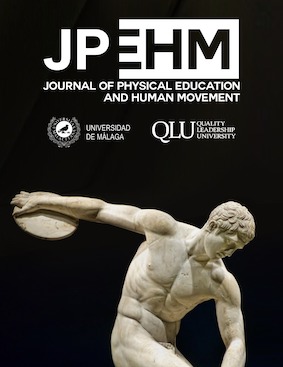CORRELACIONES ENTRE LA CONDICIÓN FÍSICA Y EL LOGRO ACADÉMICO EN ESTUDIANTES DE GRADO
DOI:
https://doi.org/10.24310/JPEHMjpehm.v2i1.6770Palabras clave:
Logro académico, condición físico, estudiante universitario, género, ejercicio, tabaquismoResumen
Introducción: Hay pocos estudios que hayan examinado el efecto del nivel de aptitud física sobre el éxito académico en estudiantes universitarios. Objetivos: El propósito del estudio es determinar la relación entre la aptitud física y el éxito académico en estudiantes universitarios. Material y método: El estudio incluyó a 183 estudiantes universitarios. Para determinar la aptitud física se utilizó la batería Fitnessgram. Los estudiantes fueron agrupados respecto al estado de éxito académico de acuerdo con las calificaciones académicas generales. Resultados: El éxito académico se evaluó como bajo en 16.1% (n: 15) de las mujeres, moderado en 38.7% (n: 36) y alto en 45.2% (n: 42), y en los estudiantes varones se determinó un nivel bajo en 18.9 % (n: 17), moderado en 52.2% (n: 47) y alto en 28.9% (n: 26). Se observó que fumar cigarrillos había creado una diferencia en las mujeres con bajo éxito académico (p <.05). Se determinó una diferencia entre los grupos de éxito académico bajo y alto de ambos sexos con respecto a la aptitud física (p <.05). En las pruebas de aptitud física, se observó una relación con los puntos académicos generales medios en todos los estudiantes, con excepción del índice de masa corporal (IMC), se determinó una relación entre otros parámetros y el éxito académico (p <.05). Conclusiones: Un nivel alto de condición física contribuye positivamente al éxito académico. No se determinó ninguna relación entre el IMC en las mujeres y los puntos académicos generales promedio. En las mujeres con bajo nivel de éxito académico la tasa de tabaquismo fue mayor.
Descargas
Métricas
Citas
Blom, L. C., Alvarez, J., Zhang, L., Kolbo, J. (2011). Associations between Health-Related Physical Fitness, Academic Achievement and Selected Academic Behaviors of Elementary and Middle School Students in the State of Mississippi. ICHPER-SD Journal Of Research, 6(1), 13-19.
Calestine, J., Bopp, M., Bopp, C. M., Papalia, Z. (2017). College student work habits are related to physical activity and fitness. International journal of exercise science, 10(7), 1009.
Carlson, S. A., Fulton, J. E., Lee, S. M., Maynard, L. M., Brown, D. R., Kohl III, H. W., Dietz, W. H. (2008). Physical education and academic achievement in elementary school: data from the early childhood longitudinal study. American journal of public health, 98(4), 721-727.
Castelli, D. M., Hillman, C. H., Buck, S. M., Erwin, H. E. (2007). Physical fitness and academic achievement in third-and fifth-grade students. Journal of Sport and Exercise Psychology, 29(2), 239-252.
Chomitz, V. R., Slining, M. M., McGowan, R. J., Mitchell, S. E., Dawson, G. F., Hacker, K. A. (2009). Is there a relationship between physical fitness and academic achievement? Positive results from public school children in the northeastern United States. Journal of School Health, 79(1), 30-37.
Eveland-Sayers, B. M., Farley, R. S., Fuller, D. K., Morgan, D. W., Caputo, J. L. (2009). Physical fitness and academic achievement in elementary school children. Journal of Physical Activity and Health, 6(1), 99-104.
Gutin, B., Manos, T., Strong, W. (1992). Defining health and fitness: First step toward establishing children's fitness standards. Research Quarterly for exercise and Sport, 63(2), 128-132.
Jeoung, B. J., Hong, M. S., Lee, Y. C. (2013). The relationship between mental health and health-related physical fitness of university students. Journal of exercise rehabilitation, 9(6), 544.
Kwak, L., Kremers, S. P., Bergman, P., Ruiz, J. R., Rizzo, N. S., Sjöström, M. (2009). Associations between physical activity, fitness, and academic achievement. The Journal of pediatrics, 155(6), 914-918.
London, R. A., Castrechini, S. (2011). A longitudinal examination of the link between youth physical fitness and academic achievement. Journal of School Health, 81(7), 400-408.
Rasberry, C. N., Lee, S. M., Robin, L., Laris, B. A., Russell, L. A., Coyle, K. K., Nihiser, A. J. (2011). The association between school-based physical activity, including physical education, and academic performance: a systematic review of the literature. Preventive medicine, 52, S10-S20.
Scheuer, L. J., Mitchell, D. (2003). Does physical activity influence academic performance. The New PE and Sport Dimension, 12.
Scott, S. P., De Souza, M. J., Koehler, K., Murray-Kolb, L. E. (2016). Combined iron deficiency and low aerobic fitness doubly burden academic performance among women attending university. The Journal of nutrition, 147(1), 104-109.
Simpson, W. F., Brehm, H. N., Rasmussen, M. L., Ramsay, J., Probst, J. C. (2002). Health and fitness profiles of collegiate undergraduate students. HEALTH, 5(3).
Van Dusen, D. P., Kelder, S. H., Kohl III, H. W., Ranjit, N., Perry, C. L. (2011). Associations of physical fitness and academic performance among schoolchildren. Journal of School Health, 81(12), 733-740.
Wengaard, E., Kristoffersen, M., Harris, A., Gundersen, H. (2017). Cardiorespiratory fitness is associated with selective attention in healthy male high-school students. Frontiers in human neuroscience, 11, 330.
Wittberg, R. A., Northrup, K. L., Cottrel, L. (2009). Children’s physical fitness and academic performance. American Journal of Health Education, 40(1), 30-36.
Descargas
Archivos adicionales
Publicado
Cómo citar
Número
Sección
Licencia
Aquellos autores/as que tengan publicaciones con esta revista, aceptan los términos siguientes:
- Los autores/as conservarán sus derechos de autor y garantizarán a la revista el derecho de primera publicación de su obra, el cuál estará simultáneamente sujeto a la Licencia de reconocimiento de Creative Commons que permite a terceros compartir la obra siempre que se indique su autor y su primera publicación esta revista.
- Los autores/as podrán adoptar otros acuerdos de licencia no exclusiva de distribución de la versión de la obra publicada (p. ej.: depositarla en un archivo telemático institucional o publicarla en un volumen monográfico) siempre que se indique la publicación inicial en esta revista.
- Se permite y recomienda a los autores/as difundir su obra a través de Internet (p. ej.: en archivos telemáticos institucionales o en su página web) antes y durante el proceso de envío, lo cual puede producir intercambios interesantes y aumentar las citas de la obra publicada. (Véase El efecto del acceso abierto).







15.png)
